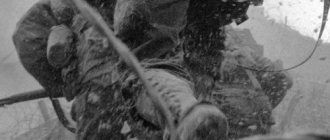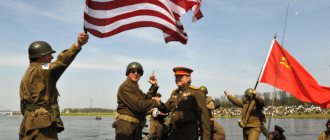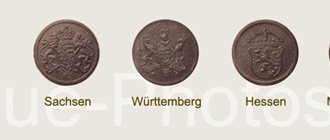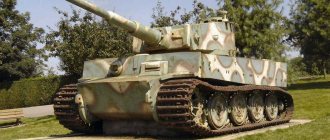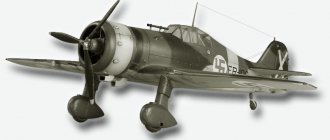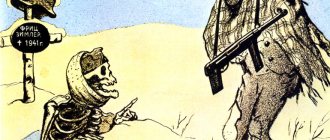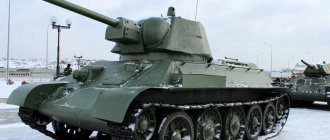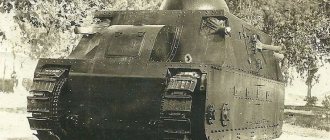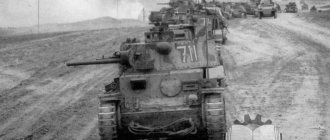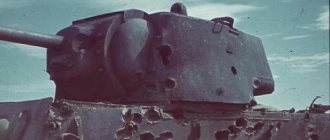All camouflage of the Third Reich was divided into 2 groups: Wehrmacht camouflage and SS camouflage. The Wehrmacht camouflage pattern included parallel lines - the so-called rain effect. There was no “rain effect” on the camouflage of the SS troops. The camouflage patterns had “plant-woody” names based on the type of pattern: Erbsen (polka dots). Eichenlaub (oak leaves), Platanen (sycamore leaves).
There is a widespread misconception about the superiority of the SS troops in the use of camouflage uniforms. Regarding uniforms, the priority of the SS troops does exist, but the first camouflage capes appeared in the Italian army back in 1929, and the famous camouflage cape “Zeltbahn” became generally accepted in the Wehrmacht in 1931, that is, even before the creation of the Waffen-SS.
Zeltbahn CC in rauchtarnmuster colors
For the first time, camouflage uniforms were sent to SS troops for field testing at the end of 1937, and in June 1938 the following camouflage elements were officially approved: a reversible camouflage helmet cover (Tarnhelmuberzug), a jacket (Tarnjacke or Tarnhemd) and a face mask . In 1940, an improved technology for applying camouflage patterns to fabric was developed, after which the production of camouflage clothing was limited only to stocks of high-quality waterproof cotton fabric.
The idea of dressing SS troops in camouflage uniforms is associated with the name of SS-Sturmbannführer Wim Brand, commander of the reconnaissance unit of the Verfugungstruppe organization, which preceded the SS troops.
The first versions of camouflage patterns were developed by Professor Otto Schick, who created them by analyzing the passage of sun rays through foliage and tree branches.
Probably, Professor Schick is the author of most, if not all, camouflage options for the SS troops. In the first three years of the war, the 1937 pattern camouflage dominated, along with unofficially made jackets and trousers from Zelltbahn capes. In 1942, caps made of camouflage fabric were accepted for supply; jackets and covers for helmets of an improved type appeared, equipped with loops designed for attaching camouflage. In 1943, reversible overalls for crews of tanks and armored vehicles appeared, as well as a full-fledged winter set, which consisted of trousers, a parka, a hood and mittens. On one side the clothes were white, on the other - camouflage. The camouflage pullover-type jacket was abandoned in 1944 in favor of camouflage sets of jacket and trousers, sewn like the usual field gray uniform - getarnter Drillichanzug. Panzerkombination overalls were also abandoned; they were replaced by geiamier Panzer Drillichanzug camouflage suits, sewn like the black Panzerwaffe uniform. Initially, sets of both types were sewn from fabric with the Eichenlaubmuster pattern, better known as “all-season”. Previously, camouflage was made from fabric with a spring/autumn pattern.
The jackets (and possibly) trousers of paratroopers, introduced in 1944, were made from the same Eichenlaubmusier camouflage fabric; these jackets came to replace the Luftwaffe uniforms in paratroop units. A large amount of camouflage for the Wehrmacht and SS troops in 1944 was made from cloth requisitioned in Italy with a local camouflage pattern. At the beginning of 1945, a new type of camouflage appeared, “copied” from the British uniform, as well as a completely new camouflage, called “Leibermuster”. Very often, Wehrmacht and SS camouflage was sewn in the field or from private tailors from Zeltbahn capes.
SS-Platanenmuster
Reversible camouflage jacket in platanenmuster autumn colors
Platanenmuster camouflage was probably the earliest used by the SS troops and can also be seen in pre-war photographs. This type and its variation Eich-Platanenmuster were distinguished by the fact that its dark spots varied and were numbered from 1 to 6. The purpose of the numbers remains a matter of debate. One theory says that the numbers made it easier for soldiers to select a cape that matched the pattern and color of their suit. However, one can hardly imagine an SS soldier at the front sorting through a bunch of capes in search of a suitable pattern and color. The production of camouflage with the Platanenmuster pattern of the first type was completed in 1942. with the Eich-Platanenmuster pattern - in 1943, primarily due to the costly method of applying a camouflage pattern to fabric under military conditions. However, from stocks of already made fabric, Platanenmuster and Eich-Platanenmuster camouflage was sewn in the first half of 1944. At the end of production, for reasons of economy, camouflage was applied to Eichenlaub capes only on one side, the inner surface remained white, unpainted. Covers for helmets were also made from material with a camouflage pattern such as Platanenmuster and Eich-Platanenmuster.
Color Platanenmuster, left autumn-winter, right spring-summer
Sources [edit]
- Beaver, Michael D.; Borsarello, J. F. (1995). Waffen-SS camouflage uniform
. Schiffer. ISBN 1-84176-854-5. - Davis, Brian L. (1998). Uniforms and insignia of the German Army: 1933-1945
. Brockhampton Press. ISBN 978-1-86019-869-4. - DFI (2003). "Michael Madsen born 1971 Documentaries". Danish Film Institute. ... 2003 ... UNDER DEVELOPMENT: ... Black Forest. A film about dead corners and modern identity. The life and disappearances of Professor Otto Schick, the main German inventor of camouflage, during World War II
- Dougherty, Martin J. (2017). Camouflage at War: An Illustrated Guide from 1914 to the Present
. Amber books. ISBN 978-1-78274-498-6. - Ferguson, Robert; Lumsden, Robin (2009). Himmler's SS: Loyalty to the Death's Head. History Press. ISBN 978-0-7524-9722-8.
- Mann, Chris (2014). SS Totenkopf: History of the Totenkopf Division 1940–45. Amber books. ISBN 978-1-907446-87-0.
- Newark, Tim (2007). Camouflage
. Thames and Hudson. ISBN 978-0-500-51347-7. - Richardson, Francis (1945). Camouflage fabrics, both plain and printed, for military use by the German SS and the German Army
. Reprinted in: Borsarello, J. F. (Ed.) (1990).
SS and Wehrmacht Camouflage
, ISO Publications. - Wilkinson-Latham, Ed (2011). "A Brief History of Camouflage". Toronto Standard.
SS-Rauchtarnmuster
SS soldier in a camouflage jacket in SS-Rauchtarnmuster colors, autumn side out.
This camouflage was produced in several variations, the color of the darkest spots varied from dark brown to black. In fact, it was a variant of the Platanenmuster with an identical spring and autumn pattern. Photographs confirm the use of this type of camouflage by the SS troops from 1939, at least until 1944.
SS-Rauchtarnmuster camouflage, summer side
There were probably many more variations of this type of camouflage than any other, and some variants are extremely rare. SS-Rauchtarnmuster designs can be found on capes, covers for helmets of the first and second types, caps, jackets, including the latest military model. There are known specimens of Wintertarnanzug with the Rauchtarn pattern.
SS-Palmenmuster
Palmenmuster camo jacket, summer side out
One of the most famous and most mysterious camouflages of the SS troops is Palmenmuster. Collectors have quite a lot of examples of this type of camouflage. The first photographs of military personnel in such camouflage date back to 1939. They were taken in Poland, these were Tarnhemd of the very first type with elastic cuffs and an additional valve. As far as we know, only jackets were produced from Palmenmuster camouflage, although covers for helmets are known (for example, in the 3rd SS Division “Totenkopf”), but they were most likely cut out from jackets.
autumn side palmenmuster
However, the production of covers with the Palmenmuster pattern in addition to jackets of the same pattern would seem logical, but nothing is known about the data and serial production of such covers. Apparently, after 1942, jackets made from Palmenmuster fabric were not produced. No “second type” jackets for attaching camouflage have been found, but a photograph taken on August 27, 1943, of Oberststurmbannführer Ernst Haussler from the SS “Toten’s Head” division in a brand new jacket of the Palmenmuster pattern, equipped with loops for attaching a camouflage, is known. However, it is not at all necessary that Hauseler did not have his jacket made by a tailor. The Palmenmuster camouflage pattern was extremely popular among the SS troops. It was worn by everyone, from privates to officers. Photographs of SS soldiers in Palmenmuster camouflage were taken even in the winter of 1944 - 1945 in the Ardennes. On early-type jackets, the design was partially made in the form of stripes, for which the troops called them “tiger” ones. There are a lot of photographs taken mainly in the Death's Head division, during the initial phase of Operation Barbarossa, which depict soldiers in jackets with Palmenmuster camouflage, jackets with modified pockets made like pockets in uniforms, perhaps a factory version, or perhaps a modification tailoring workshops of the division. There are also photographs of soldiers fully dressed in Palmenmuster camouflage. Most likely, in these cases, the trousers were cut from the jacket by some tailor. The jacket with a zipper sewn into it and fastenings for shoulder straps are sewn into the shoulders has survived to this day.
17.07.2016
Today, the Bundeswehr uniform in flecktarn colors, in addition to military style lovers, airsoft players and reenactors, is actively used by hunters, fishermen and lovers of all types of outdoor recreation and more. The statutory uniform of the Bundeswehr and the flecktarn camouflage itself have proven themselves to be the best. Both from the point of view of camouflage and from the point of view of convenience. For seasoned hunters and fishermen, having classic army gear in flecktarn camouflage is considered almost a sign of good form.
One of the secrets of the popularity of the Bundeswehr uniform is the fabric. Although these are the usual, often found various combinations of polyester and cotton, thanks to a special type of weaving, the result is wear-resistant things that people say that a person is tired of wearing, they do not “kill” in any way. And the flecktarn camouflage itself, the idea of which appeared during WWII, is still considered one of the best and most successful camouflage colors. On the European continent, it breaks up the silhouette well and camouflages on any terrain.
Non-contract manufacturers of various military-oriented equipment and equipment, of course, actively use Flecktarn camouflage and Bundeswehr technological developments in their products. As a result, the range of useful and functional products in the famous German camouflage pattern is very wide. By supplementing with time-tested statutory items, every lover of outdoor activities can easily equip himself from head to toe for all seasons in one of the best camouflages in the world...
Spring and autumn, in terms of weather, can be different, especially in Russia. Therefore, a set of a statutory jacket and trousers in flecktarn camouflage can be complemented with a fleece sweater from Sturm. As a result, you get a comfortable three-layer set: a Germany flecktarn jacket, Germany flecktarn trousers and, for insulation, a Germany flecktarn sweater. Continuing the theme - a flecktarn T-shirt is perfect as underwear.
The combination of a jacket and a fleece jacket is good, but it may not be enough. When it’s cold, damp outside and an “evil” wind is blowing... The jacket can be replaced with an M-65 flecktarn jacket with a Sturm liner. This model, which copies the legendary American field jacket, is in every sense an excellent solution and the right choice.
Many manufacturers of the legendary M-65 jacket offer to purchase the jacket and liner separately. In the case of a jacket from the Sturm company, this is a ready-made set: a jacket and an insulating lining. There is no need to separately search and select a “liner”, which, depending on the manufacturer, may not be fastened. There is immediately a wide range of uses in every sense. You can wear a jacket without a lining, and it will be a jacket for warm and cool weather. Together with the lining, this is already a warm jacket, which is comfortable down to -10C Celsius. The jacket is universal and suitable for both everyday wear and outdoor recreation. The flecktarn camouflage is convenient because dirt is practically invisible, even if it is there... When you need something that you can quickly put on yourself if the weather suddenly deteriorates and it starts to rain, there is an excellent solution - the Sturm flecktarn rain suit. Lightweight, very compact, simple - a jacket and trousers that reliably protect from rain and wind. This flecktarn camouflage suit is ideal for travel and outdoor activities. The suit fabric can withstand pressure of 5000 mm of water column. In other words, a column of water five meters high...
The statutory parka Germany flecktarn is a separate story in itself, a special article is dedicated to it: The BW Flecktarn parka is a universal jacket for any task. This camouflage parka jacket is often also called an unloading vest. The many pockets allow you to easily organize all your essentials while keeping your hands free. To increase functionality and seasonal mobility, the pedantic Germans could not help but develop a suitable underlay. The liner is not attached to the parka in any way, it is put on inside and, in general, is a completely independent thing. Early versions of this kit did have elements to attach the liner and parka to each other, but that is now a thing of the past.
The parka is equipped with a wonderful anatomical hood that provides protection from wind and light rain. The parka is also relevant in the cold season, if it is complemented with a warm lining and a warm hat. The Bundeswehr military is provided with a comfortable winter cap Germany flecktarn. The coloring is traditional Bundeswehr camouflage. This is both a warm hat and a cap with earflaps.
For more serious protection from heavy rain and other precipitation, and most importantly, to increase comfort, it is better to use membrane clothing. As you know, membrane clothing “breathes” perfectly, that is, it is ventilated, maintaining comfortable heat exchange in any conditions. Putting together a comfortable, comfortable and breathable flecktarn camouflage kit couldn't be easier.
Let's start from the bottom up: Gore-tex trousers (Sympatex) Germany flecktarn, the so-called “cover trousers”. These trousers are worn over what is already worn. For example, the weather has changed - it started to rain, it’s hard to say how long it will last, and changing clothes takes too long. The situation is just right for our membrane trousers. There are no pockets as such on the trousers; in their place there are slits through which easy access to the pockets of the main clothing is provided. The important thing is that they are completely made of synthetic material and after any adventures in the dirt, you just need to rinse them - your main clothes will remain clean. These trousers are especially good during outdoor activities, no matter what it is - a tourist trip, hunting or fishing.
Gore-tex jacket (Sympatex) Germany flecktarn is an independent jacket that can and should be used for its intended purpose. The jacket has a very wide range of capabilities and applications. Its direct purpose is a military jacket, but it is easy to buy, and every lover of military and camouflage can use it wherever he wants, up to daily use as an advanced and comfortable rain jacket. For cool weather, you also need to protect your hands. Soft TACTICAL flecktarn Germany Gloves, like other items in this review, kill two birds with one stone. Firstly, these are soft and warm gloves with reliable protection for the palm and fingers. Secondly, the Breathtex material, one of the layers of material in these gloves, works almost like a membrane.
The last, final stage is shoes. Camouflage combat boots are not practical and they are not often found, but if we have already decided to equip ourselves in flecktarn camouflage from head to toe, the problem will have to be solved. Gore-tex flecktarn BW gaiters will help with this. In addition to the visual part, gaiters solve many practical problems - they protect shoes and trousers from all types of precipitation and dirt, and also prevent small stones from getting into the shoes.
**** The range of clothing and equipment in flecktarn camouflage is very diverse. You can find complete autumn-winter equipment in our retail stores or the Force-age online store.
***
“We work throughout Russia: St. Petersburg, Novosibirsk, Yekaterinburg, Nizhny Novgorod, Kazan, Chelyabinsk, Omsk, Samara, Rostov-on-Don, Ufa, Krasnoyarsk, Perm, Voronezh, Volgograd, etc.
Fast delivery to the Moscow region: Balashikha, Podolsk, Khimki, Korolev, Mytishchi, Lyubertsy, Elektrostal, Krasnogorsk, Kolomna, Odintsovo, Serpukhov, Shchelkovo, Domodedovo, Orekhovo-Zuevo, Ramenskoye, Zhukovsky, Pushkino, Sergiev Posad, Dolgoprudny, etc.”
SS-Eich-Platanenmuster
Jumpsuit in Eich-Platanenmuster summer side out
This camouflage combines patterns such as “oak” leaves and “sycamore leaves”. Small spots in the spirit of oak leaves are superimposed on large dark spots like a “sycamore” pattern. Analysis of photographs suggests that the fabric with the Eich-Platanenmuster camouflage pattern was produced in 1942 - 1943. Usually, jackets of the so-called “Second Type” were made from such fabric. The fabric camouflaged with the Eich-Platanenmuster pattern was also used to make covers for helmets. Typically, jackets of the first type are associated with Platanenmuster camouflage, and jackets of the second type are associated with Eich-Platanenmuster camouflage. Zeltbahn capes, field caps and tank crew overalls were also made from fabric with the Eich-Platanenmuster pattern. Somewhere in the first half of 1943, the Eich-Platanenmuster camouflage disappeared from the troops, although individual examples were found in 1944.
Camouflage Eich-Platanenmuster autumn-winter side out
SS-Beringt-Eichenlaubmuster
Summer side of Beringt-Eichenlaubmuster
“Round oak leaves” is a variant of “oak” camouflage with rounded spots. It's possible. that this option is the earliest version of the “oak leaves” camouflage. Researchers date the beginning of the production of camouflage of this pattern to 1942. In black-and-white wartime photographs, it is almost impossible to distinguish “cool oak leaves” from simply “oak leaves.” The fabric of the Beringt-Eichenlaubmuster pattern was used to make covers for helmets, jackets, caps and capes, and possibly for tank crew overalls. The differences between Beringt-Eichenlaubmuster and Eichenlaubmuster are most noticeable in the Wintertarnanzug winter parks. Only “autumn” camouflage was applied to winter parkas.
SS-Eichenlaubmuster
Eichenlaubmuster camouflage with summer side out
The word “regular” is often added to the “oak leaf” design to distinguish it from “round bast leaves.” The Eichenlaubmuster camouflage pattern is the most typical of jackets surviving from the war to the present day, which, however, does not reduce its value, especially for collectors specializing in Normandy and the Ardennes. This type of camouflage pattern appeared no earlier than 1942 - no authentic jackets of the first type, sewn from fabric with the Eichenlaubmuster pattern, have yet been discovered. But jackets and covers for helmets of the second type, made from Eichenlaubmuster material, are common. Presumably, Zeltbahn capes made of fabric with the Eichenlaubmuster pattern were sewn until the end of the war
Autumn side of Eichenlaubmuster camouflage
SS-Erbsenmuster
SS-Erbsenmuster camouflage. The jacket on the left is a replica, and on the right is the original
.
The SS-Erbsenmuster camouflage was considered all-season and was not divided into autumn-winter and spring-summer.
The order of March 1944 established the wearing of a uniform consisting of two pieces of camouflage color getarnter Drillichanzug. This type of clothing was intended to replace an almost white work uniform and to be worn in a combat situation. The uniform was sewn according to the patterns of a simplified uniform and accompanying trousers, introduced for the Wehrmacht and SS troops in 1943. In January 1944, instead of overalls, camouflage trousers with jackets for tankers were introduced.
The exact date for the start of production of a new type of mold has not yet been established. Presumably, it appeared back in 1943, but it became widespread precisely in 1944. As has been repeatedly noted, the first copies of this form were sewn from “stock” camouflage fabric with the Eichenlaubmuster pattern. According to the specifications, the new uniform was to be sewn from an “all-season” camouflage pattern, so there was no need to make it reverse. The new camouflage is called “Erbsenmuster” - with polka dots. The surviving examples of the “Erbsenmuster” camouflage were sewn mainly from smooth cotton fabric and ribbed NVT fabric, which was not of high quality, wore out quickly and became very dirty.
Erbsenmusier fabric was also used to make winter parkas, although photographs of such parkas taken during the war are quite rare. Most likely, such parkas were made only during the last war winter, and very few such warm jackets reached the front. For example, such parks almost never fought in the Ardennes. Officially, covers for helmets and caps made of fabric with the “Erbsenmuster” pattern were not used, however, similar examples were in circulation at the front.
Military uniform of soldiers and officers of the Second World War
In accordance with the Hague Conventions, wearing a military uniform during hostilities or armed conflicts is a necessary condition for defining military personnel as legal combatants with all the special rights that flow from this status. At the same time, a mandatory element of the military uniform is insignia, which clearly indicates membership in the armed forces of one or another side of the armed conflict. The people's militia participating in such conflicts may wear a variety of uniforms, but must have distinguishable signs (bandages, crosses, etc.) at least at a shooting distance.
The content of the article
Front-line soldier
Corporal (1) in a 1943 model uniform. Rank insignia from the buttonholes was transferred to shoulder straps. The SSh-40 helmet became widespread since 1942. At about the same time, submachine guns began to arrive in large quantities to the troops. This corporal is armed with a 7.62 mm Shpagin submachine gun - PPSh-41 - with a 71-round drum magazine. Spare magazines in pouches on the waist belt next to a pouch for three hand grenades. In 1944, along with the drum magazine for the PPSh-41, a 35-round open-arm magazine began to be produced, also suitable for the PPS-43. Horn magazines were carried in pouches in three compartments. Grenades were usually carried in pouches on the waist belt.
By the beginning of the war, there were pouches for one grenade, in this case the F-1 (Za) grenade is shown. More practical pouches for three grenades appeared later; a pouch with a fragmentation grenade RG-42 (Зb) is shown. Pouches with two compartments were intended for RGD-33 high-explosive grenades; here is a grenade with a fragmentation ring (Zs) attached. The 1942 model duffel bag had a design that was simple to the point of primitiveness.
Each compartment had an ax, which was carried by one of the soldiers on a waist belt in a special case (5). A new type of pot (6), similar to the German model. Enamel mug (7). Due to the shortage of aluminum, glass flasks with a cork stopper were found among the troops (8). The glass of the flask could be green or brown, or transparent. The flasks were hung from the waist belt using a fabric cover. The BN gas mask was equipped with a conversation box and an improved TSh filter (9). Gas mask bag with two side pockets for spare eyepiece glasses and a pencil with anti-fog compound. The pouch for spare ammunition was hung on the back to the waist belt and could hold six standard five-round rounds (10).
Rookie
Private (1 and 2) in a summer field uniform, model 1936, with insignia, model 1941. Helmet, model 1936, and boots with tapes. Field equipment of the 1936 model, almost all equipment of this type was lost in the first year of fighting. The equipment includes a duffel bag, a roll with an overcoat and a raincoat, a food bag, cartridge pouches with two compartments, a sapper shovel, a flask and a gas mask bag. The Red Army soldier is armed with a 7.62 mm Mosin rifle, model 1891/30. The bayonet is attached in the opposite direction for ease of carrying. Shown are a bakelite medallion (3), a sapper's shovel with a cover (4), an aluminum flask with a cover (5), a bandoleer for 14 rifle clips (6). Later, instead of leather equipment, canvas equipment was produced. Two five-round clips (7) were placed in each compartment of the cartridge pouch. The idle pot (8) served both as a saucepan and as a bowl. Boots (9) with windings (10). BS gas mask with bag (11). The protrusion between the eye sockets made it possible to wipe the fogged glass from the inside and clear the nose. The gas mask was equipped with a T-5 filter.
German corporal uniform (non-commissioned officer), 1939-1940
01 - M-35 field jacket with non-commissioned officer insignia 02 - M-35 steel helmet with Heeres markings, 03 - Zeltbahn M-31 camouflage fabric tent "Splittermuster", 04 - gray ("Steingrau") trousers, 05 - leather belt, 06 — filter bags for a gas mask, 07 — M-38 gas mask, 08 — M-24 grenade, 09 — black leather pouch, 10 — M-31 aluminum bowler hat, 11 — boots, 12 — 7, 92 mm Mauser 98k, 13 — Seitengewehr 84/98 bayonet, 14 — sapper blade.
Lieutenant's uniform of the 82nd Airborne Sicily, 1943
01 - M2 helmet with camouflage net, 02 - M1942 jacket, 03 - M1942 trousers, 04 - M1934 wool shirt, 05 - boots, 06 - M1936 Loading belt with M1916 holster for Colt M1911 and pistol, 07 - M1936 shoulder straps, 08 - Carbine M1A1, 09 - M2A1 gas mask, 10 - M1910 folding shovel, 11 - M1942 bowler hat, 12 - M1910 bag, 13 - dog tags, 14 - M1918 Mk I knife, 15 - M1936 backpack.
Luftwaffe uniform Hauptmann (captain), FW-190-A8 pilot, Jagdgeschwader 300 "Wild Sau", Germany 1944
01 - LKP N101 headphones, 02 - Nietzsche & Gunther Fl. 30550 glasses, 03 - Drager model 10-69 oxygen mask, 04 - Hankart, 05 - AK 39Fl. compass, 06 - 25 mm Walter Flarepistol M-43 with ammunition on the belt, 07 - holster, 08 - FW-190 parachute, 09 - aviation boots, 10 - M-37 Luftwaffe breeches, 11 - Luftwaffe leather jacket with Hauptmann and Luftwaffe emblem bandage.
Private ROA (Vlasov's army), 1942-45
01 — Dutch field jacket with ROA on the buttonholes and shoulder straps, Heeres eagle on the right chest, 02 — M-40 trousers, 03 — medallion, 04 — M-34 cap with ROA, 05 — boots, 06 — M-42 gaiters, 07 — Grman unloading belt with pouch, 08 — M-24 grenade, 09 — M-31 bowler hat, 10 — Bayonet, 11 — M-39 straps, 12 — M-35 helmet with camouflage net, 13 — “New Life” magazine for “Eastern” volunteers, 14 - 7.62 mm Mosin 1891/30
US Army Infantry Uniform 1942-1945
01 - M1 helmet, 02 - M1934 shirt, 03 - M1934 sweatshirt, 04 - M1941 trousers, 05 - boots, 06 - M1938 leggings, 07 - M1926 lifebuoy, 08 - M1937 ammunition belt, 09 - M1924 personal care products, 10 — M1910 bowler hat, 11 — gas mask, 12 — M1918A2 Browning Automatic Rifle with M1907 belt, 13 — stripes, 14 and 15 — manuals, 16 — sleeve badges: A — 1st Armored, B — 2nd, C — 3- I am infantry, E is the 34th, F is the 1st infantry.
Kriegsmarine (navy) Matrosengefreiter, 1943
01 - naval jacket, Iron Cross 2nd class, veteran crew badge on the left side of the chest, Matrosengefreiter insignia 02 - Kriegsmarine cap, 03 - naval peacoat, 04 - "deck" trousers, 05 - "Signal" magazine, July 1943 , 06 - tobacco, 07 - cigarette paper, 08 - "Hygenischer Gummischutz-Dublosan", 09 - boots.
Major of the maintenance unit of the 1st Polish Armored Division, Germany, 1945
01 - M 37/40 casual uniform, 02 - black shoulder strap of the 1st Armored Division, 03 - 1st Div badge, 04 - Silver cross from the Virtuti Militari, 05 - M 37 shoulder straps, 06 - 11.43 mm Colt M1911 pistol, 07 - officer's boots, 08 - leather vest, 09 - drivers' gloves, 10 - helmet for driving armored units, 11 - AT Mk II motorcycle helmet, 12 - Mk II helmet, 12 - leggings.
Private, Luftwaffe, France, 1944
01 - M-40 helmet, 02 - Einheitsfeldmütze M-43 cap, 03 - M-43 camouflage T-shirt "Sumpftarnmuster", 04 - trousers, 05 - shoulder straps, 06 - 7.92 mm Mauser 98k rifle, 07 - M-31 breadbag , 08 — M-31 bowler hat, 09 — M-39 boots, 10 — medallion, 11 — “Esbit” pocket heater.
Lieutenant's uniform, RSI "Decima MAS", Italy, 1943-44
01 — “Basco” beret, 02 — model, 1933 helmet, 03 — model, 1941 flight jacket, leutenant badges on cuffs, lapel badges, 04 — German belt, 05 — Beretta 1933 pistol and holster, 06 — German M-24 grenade, 07 - 9 mm TZ-45 SMG, 08 - pouches, 09 - trousers, 10 - German mountain boots, 11 - participation badge.
8 SS-Kavallerie division "Florian Geyer", summer 1944
01 - M-40 Feldmutze cap, 02 - M-40 helmet with SS badges, 03 - field jacket 44 - new cut, cavalry badges on shoulder straps, 04 - trousers, 05 - M-35 belt, 06 - wool shirt, 07 - M-39 shoulder straps, 08 — “Florian Geyer” bandage, 09 — woolen gloves, 10 — Panzerfaust 60, 11 — 7.92 mm Sturmgewehr 44, 12 — M-84/98 bayonet, 13 — canvas pouches, 14 — M- 24 grenades, 15 — Waffen SS salary card, 16 — M-31 bowler hat, 17 — M-43 leather boots, 18 — Leggings.
Captain (Kapitanleutnant) - submarine commander, 1941
01 - officer's jacket, Kapitanleutnant insignia, 02 - Kninght Cross of the Iron Cross, 03 - submarine insignia, 04 - Unofficial insignia of the 1st and 9th U-boat flotillas, 05 - cigarette cap of Kriegsmarine officers -, 06, 07 - leather gloves, 08 - leather coat "U-Boot-Päckchen", 09 - boots, 10 - "Junghans", 11 - naval binoculars.
Partisan of the Peasant Battalion (Bataliony Chlopskie), Poland, 1942
01 — wz.1937 “rogatywka” cap, 02 — jacket, 03 — trousers, 04 — boots, 05 — improvised bandage, 06 — 9 mm MP-40 SMG.
Soviet tank commander uniform, 1939
01 - canvas hat with headphones, 02 - model 1935 cap with a red star, 03 - linen overalls, 04 - canvas bag for a gas mask, 05 - officer boots, 06 - holster for 7.62 mm Nagant, 07 - leather tablet. , 08 - officer's belt.
Polish infantry uniform, 1939
01 - wz.1939 "rogatywka" cap, 02 - wz.1937 "rogatywka" cap, 03 - wz.1937 steel helmet, 04 - wz.1936 jacket, 05 - badge, 06 - WSR wz.1932 gas mask in a canvas bag, 07 — hygiene products, 08 — leather pouches, 09 — wz.1933 breadbag, 10 — leather unloading belt, 11 — wz.1938 bowler hat, 12 — wz.1928 bayonet, 13 — folding shovel in a leather case, 14 — wz.1933 backpack with blanket, 15 - biscuits, 16 - wz.1931 combination bowler, 17 - spoon + fork set, 18 - owijacze fabric belts used instead of socks, 19 - boots, 20 - GR-31 fragmentation grenade, 21 - GR -31 offensive grenades, 22 - 7.92 mm Mauser 1898a rifle, 23 - 7.92 mm cartridge clips, 24 - WZ. 1924 bayonet.
Private, Red Army, 1939-41
01 — Ushanka hat, 02 — coat, 03 — felt boots, 04 — belt, 05 — 7.62 mm Tokarev SVT-40 rifle, 06 — bayonet, 07 — ammunition, 08 — gas mask bag, 09 — folding shovel.
NKVD lieutenant, 1940-41
01 - model 1935 NKVD cap, 02 - model 1925 NKVD tunic, 03 - dark blue cloth trousers with crimson piping, 04 - boots, 05 - waist belt, 06 - holster for Nagan 1895 revolver, 07 - model 1932 officer's tablet, 08 — NKVD Badge installed in 1940, 09 — Red Star badge, 10 — military ID, 11 — cartridges for a revolver.
Soviet infantry, 1941
01 - model 1940 steel helmet, 02 - padded jacket, 03 - field trousers, 04 - boots, 05 - 7.62 mm Mosin 91/30 rifle, 06 - rifle oiler, 07 - model 1930 bandolier, 09 - military ID, 10 - tablet.
Soviet infantry, officer, 1943
01 - model 1943 "tunic" sweatshirt, officer version, 02 - model, 1935 breeches, 03 - model, 1935 Cap, 04 - model, 1940 helmet, 05 - model, 1935 officer's belt and shoulder straps, 06 - holster for Nagant, 1895 , 07 - tablet, 08 - officer's boots.
Red Intelligence Officer, 1943
01 - model 1935 cap, 02 - camouflage clothing, autumn, 03 - 7.62 mm PPS-43, 04 - canvas bag for ammunition, 05 - officer's belt 1935, 06 - leather case with 7.62mm TT Pistol, 07 - model , 1940 knife, 08 — Adrianov’s compass, 10 — officer’s boots.
Source
SS-Leibermuster
Information about the latest type of camouflage for the SS troops was gleaned from the papers of US Army Quartermaster Francis Richardson, who soon after the end of the war compiled a report on the types of camouflage for the German armed forces. According to Sir Richardson, the latest camouflage, like the very first camouflage of the SS troops, was developed by Professor Schick. The most recent camouflage pattern was the only one that received an official name; the names of all other camouflage patterns are unofficial. The new camouflage was intended to replace all types of camouflages of the Wehrmacht and SS troops. The design was applied to the fabric with a special light-absorbing paint, which also reduced IR radiation. The process of making such camouflage fabric was more complex and time-consuming than the production of fabric with previous types of camouflage patterns. According to Richardson, the new fabric was intended primarily for winter clothing and capes. Very few soldiers managed to receive the new camouflage before the end of the war. Richardson's papers do not contain any information about the Leibermuster twill fabric of the 1944 field kits that have appeared on the market over the past few years. Richardson described several examples of clothing camouflaged with the Leibermiister pattern, but all were made from a smooth fabric that is associated with the fabric of capes and winter parkas. All known collectible uniforms made from NVT fabric with the Leibermuster pattern were made by enterprising businessmen from Eastern European countries, however, there is evidence that similar camouflage was sewn in the first post-war years in Czechoslovakia (in the 50s they produced their own version of the Leibermuster camouflage), and the cut of the Czechoslovak military The costume was copied from the German one, and sometimes the uniform was made by the same factories that worked for the Reich during the war. Photos of camouflage uniforms with the Leibermuster pattern. dating from the war period are extremely rare. There is a known photograph of a fighter wearing a jacket with a Leibermuster pattern, very similar to a jacket made of NVT Sumpfmuster 44 fabric. Richardson might not have known about NVT jackets with a Leibermuster pattern, since he was only describing camouflage. which occurred on the Western Front and did not affect the military clothing of the Eastern Front.
Further reading[edit]
- Mollo, Andrew (1987). The Armed Forces of World War II: Uniforms, Insignia and Organization
. Little, Brown. - Palinks, Werner; Borsarello, J. F. (2002). Camouflage uniform of the German Wehrmacht
. Schiffer. - Peterson, Daniel (1998). Europa Militaria No. 17: Wehrmacht camouflage uniform and its post-war models
. Crowwood Press. - Peterson, Daniel (2001). Europa Militaria No. 18: Waffen SS camouflage uniform and post-war models thereof
. Crowwood Press. - Stephen, Andrew; Amodio, Peter (1998). Europa Militaria No.
6: Waffen SS uniforms in color photographs . Crowwood Press.
Italienischestarnmuster
Soldier in Italian camouflage jacket
The Italian camouflage pattern first appeared in 1929 ponchos. The Italian camouflage pattern was used for the longest time in history, remaining virtually unchanged until the 90s of the 20th century. In 1943, the Germans received significant supplies of Italian camouflage fabric. Italian camouflage clothing is widely represented in photographs of soldiers and officers of the 1st SS Panzer Division Leibstandarte SS Adolf Hitler and the 12th SS Panzergrenadier Division Hitler Youth. No less famous are photographs of generals Sepp Dietrich and Kurt “Panzer” Meyer in Italian camouflage. Almost all versions of the German field military uniform were made from Italian camouflage fabric, both en masse in factories and from private entrepreneurs. The factories also produced uniforms with four pockets, model 1943, parkas with hoods, triangular raincoats, identical to the Zeltbahn capes, but camouflaged on only one side. There are known photographs of jackets cut by the SS troops, but made from Italian camouflage. Italian camouflage was also used to sew caps and factory-made tank overalls.
Introduction
The German 5FT Flecktarn camouflage pattern is one of those that you immediately associate with the national army. Due to its long history, effectiveness and popularity, it is used not only by German soldiers, but also by a huge number of ordinary people in everyday life who want to make a fashion statement in this way. The print has come a long way since its creation. As time passed, it managed to maintain its position even as many other countries switched to new, more versatile colors such as Multicam and its derivatives.
Sources of the Flecktarn concept
As with most camouflage prints, the Flecktarn print's roots lie in the research and development of camouflage technology before and during World War II. While there are many opinions among camouflage experts and aficionados as to how much of an influence this period actually had, it is obvious even to the untrained eye that to this day the creators of camouflages such as "Plane Tree" and "M44 Pea Dot" ", were inspired by the period of the Second World War.
Spotted colors with polka dots, rounded shapes designed to break up the silhouette - all this looks like the camouflage patterns created by Otto Schick and his research team. Obviously, these are not direct copies of Chic's work. However, the principles and basic design concepts remain the same. Schick first used the polka dot concept, developed in 1936 by the Camouflage Department, to create camouflage prints for SS soldiers. Based on these concepts, many countries began to develop their own camouflage prints, using multi-colored spots to camouflage and break up the silhouette of soldiers.
Given these premises, it is not surprising that during the Second World War, German soldiers wore clothing made from surplus fabric in precisely these camouflage colors. In fact, more than 10 countries dressed their soldiers in either surplus German fabrics or copies painted in the likeness of the German original. This is seen not only as a pragmatic approach, dictated by the economic situation that arose due to one of the largest European conflicts. The armies of many countries made this decision for reasons of the effectiveness of the concept.
Use of the Bundeswehr by the army
The history of spotted camouflage prints continued in post-war Germany. Soon after the restoration of forces, the German armed forces resumed experiments with camouflage, based on pre-war developments. The advent of the Cold War in the late forties forced Germany and France to redouble their efforts in this direction. Together with Italy and the Benelux countries, Germany tried unsuccessfully to negotiate the creation of a European Defense Committee.
As a result of the failure of these negotiations, the German Army moved away from the jointly developed camouflage prints and instead began using a modified version of the Splittertarn camouflage as its standard pattern. The use of this design continued until the early sixties, until the German Army began wearing uniforms in the standard green NATO camouflage print.
The situation changed in 1976, when camouflage again became the focus of attention, which attracted the Test of Bundeswehr troops. During the trials, some of the camouflage prints were tested and rated based on their effectiveness. Again, the World War II influence was evident, with most of the designs tested being inspired by German prints such as Plane Tree and M44 Pea Dot.
Flecktarn - as we know it today - was part of these trials and was called "Flecktarn B". Among the other prints, there were two more versions of Flecktarn - one with smaller elements and one with less contrast. However, the tests did not bring any results due to economic and political difficulties. These tests took place 10 years before Germany began the process of producing camouflage uniforms for its army soldiers again. Since 1986, two variations of the Flecktarn print have been tested. Four years later, the Flecktarn B print was chosen as the basis for the Kampfanzug 90 combat suit.
Since the beginning of 1991, the five-color Flecktarn pattern (5 Farb Tarndruck, also known as 5FT) has become the official camouflage of the Bundeswehr. The pattern combines the following colors:
- light green (15%);
- light olive (20%);
- dark green (35%);
- brown (20%);
- black (10%).
The evolution of the 5FT Flecktarn print
As with many camouflage prints, the Flecktarn pattern has undergone several modifications. Its color scheme has also evolved. At the very beginning it was a three-color version for dry areas called "Tropentarn" (erroneously also called "Wüstentarn"). The print was designed for the 1993-94 operation in Somalia. It would later be used for operations in Afghanistan, as well as in hot spots around the world.
Not everyone knows that the 5FT Flecktarn print is the fifth version of the original design, which has undergone significant changes to the color scheme. This was done to improve the effectiveness of the print, not only in terms of blending with the environment and breaking up the silhouette, but also to keep pace with developments in infrared radiation sources and the need to camouflage in invisible spectra.
The Flecktarn print continues to evolve. Several other variants currently exist, each designed for specific operational needs, including snowy, mountainous, desert, rocky estuary or coastal environments. You can also find commercial versions of the print - they are made by a number of companies. Much more interesting is the development of a transitional version of the Flecktarn print, which follows the international trend towards the versatility of camouflage. It combines light green, dark green, brown, beige, gray and off-white colors. This variation is supposedly based on the original version of the Flecktarn print, but with six rather than five colors. It is called "Multitarn" and is exclusive to the Bundeswehr Special Armed Forces - KSK. There are currently no plans to use it in other branches of the armed forces.
Impact on other countries
Like the M81 Woodland and DPM patterns, the 5FT Flecktarn camouflage pattern decisively influenced the development of other camouflage patterns and their use in a number of countries. These three prints can be said to have inspired an entire generation of camouflage patterns, just as they themselves were based on three other WWII prints.
- Belgium interpreted the German 5FT Flecktarn print in a version worn by aviation security officials until 2000.
- In Denmark, they developed a green variation of the print, consisting of only three colors. It was tested in 1978 and continues to attract the attention of textile companies to this day. According to rumors, it was developed with the participation of the French company Texunion.
- The Netherlands even considered using the Flecktarn print as an official camouflage, but decided against it for political reasons (the Dutch authorities felt that the print was too reminiscent of the colors of the SS soldiers' uniforms during World War II).
- Japan created its own version of the Flecktarn pattern and in 1991, soldiers of the Japanese Maritime Self-Defense Force wore this particular camouflage.
- North Korea dressed its border guards in an unofficial copy of camouflage
- The People's Republic of China has equipped its border defense units with unlicensed Flecktarn. It was also used in Tibet and the Beijing Military Region - it was repainted in a browner version (which is still highly sought after by collectors).
Conclusion
Flecktarn has proven its effectiveness and has been unanimously voted the winner of many NATO forestry comparisons. The Flecktarn print easily adapts to many situations and landscapes. It has long earned its place among the best camouflage patterns for the military. For example, take the latest version of the 5FT Flecktarn print. Not only colors have been improved, but also camouflage characteristics in the infrared spectrum. Also a worthy competitor to many transitional camouflage prints is the newly arrived Multitarn.
Link to original source
Post-war camouflage of the GDR army, DDR-Russischestarnmuster
Autumn side of Russian style camouflage
This camouflage in Russian style was the first camouflage specifically designed for the National People's Army of the GDR. The cut and camouflage pattern were copied from the Soviet wartime kit. Presumably, democratic Germans began producing such clothing somewhere in 1956 - 1958, but it may have been used by border troops and police since the late 40s. There are two known variants of camouflage: with simple spots and spots surrounded by a black border. Early types of camouflage of the NNA of the GDR are poorly studied. Some even deny the very fact of the existence of “Russian” type camouflage, and the first East German camouflage is considered to be Flachentarnmuster, which appeared in the late 50s
Post-war camouflage of the Bundeswehr - Bundeswehr-Zelt-Tarnmuster
Introduced in 1956, this camouflage is the only post-war type with a pattern similar to the camouflage pattern of the SS troops, reversible with “spring” and “fall” sides. The Bundeswehr briefly tested a triangular cape with a Leibermuster-type camouflage pattern, but it was not adopted for service. The hood of the cape was detachable and could be used as a duffel bag. Two capes fastened to one another formed a tent. The camouflage pattern is a hybrid of Wehrmacht and SS camouflages. In the spring pattern the dominant color is green, in the autumn pattern it is brown. Black spots are present in both the “autumn” and “spring” patterns. This camouflage was used only for the manufacture of Zeltbahn capes. Various versions of uniforms made from this type of camouflage were made exclusively with collectors in mind. At the same time, soldiers sometimes cut out covers for helmets from camouflage capes, which were found in Bundeswehr units even in the 80s.
Flecktarn
Flecktarn - a camouflage pattern based on the absence of clear boundaries between colors, which creates an “explosive effect”, is considered one of the most effective for use in temperate climates and mixed forests. Today there are several variations of flecktarn using 4/5/6 colors (the 5 color option is the original). The following colors are used in camouflage: dark green, gray-green, brown, black, light green.
The camouflage was originally developed for the needs of the armed forces of the Federal Republic of Germany, which are mainly stationed either in Germany or in the countries of the European Union; in winter conditions, Bundeswehr soldiers use a special camouflage coat, and for combat operations they use Tropentarn camouflage, which has a similar structure, but uses different colors .
Bundeswehr soldiers in camouflage suits
Hauptmann of the Bundeswehr in tropentarn-colored equipment
A key milestone in the development of German camouflages was the Second World War, when the concept of modern flecktarn, as well as other camouflages, was laid down (see Kink).
German camouflage from the Second World War
Domestic camouflage Izlom
By the beginning of the 1980s, the Cold War, which was taking place across the border of the Federal Republic of Germany and the German Democratic Republic, dictated the need to replace the Olive, generally accepted in the Bundeswehr, with a more effective camouflage. Unfortunately, the flecktarn did not have time to be baptized by the Cold War, as it began to be used en masse in the German army in the 1990s.
Bundeswehr soldiers, early 90s, some of the soldiers are already equipped with new uniforms
Having entered service in the Bundeswehr, flecktarn began to be used by almost all units (it is worth considering that camouflage can be assigned to one or another unit, but in essence it may not be used, since the KSK does not always use flecktarn during real combat operations.)
KSK fighters
Bundeswehr paratroopers (fallschirmjager)
Bundeswehr anti-tank units
Since flecktarn declared itself to be one of the highest quality camouflages in the European region, some countries paid attention to it and were going to adopt it (Austria, Albania, Ukraine, Poland, Romania and so on), but some countries began to criticize the camouflage because due to its similarity with the camouflage used by units of the criminal organization Waffen SS, naturally these countries did not accept this camouflage (France, Holland)
Austrian Kampfanzug M 57
The camouflage is suitable for modeling: the German Bundeswehr army, Austrian sniper units, Belgian paratroopers, Japanese self-defense forces.
Japan Self-Defense Forces
Our online store offers a wide range of products in Flecktarn colours,
Knee pads
Camouflage tape
Backpacks
Flask with pouch for the Bundeswehr unloading system
Pouches for stores
Legendary Bundeswehr parka
Post-war camouflage, DDK-Flachentarnmuster
This type of camouflage was adopted for supply by the NNA of the GDR in the late 50s; it replaced the “Russian” style camouflage. The exact date of the introduction of camouflage has not been established, but photographs of the “Russian” Flachentarnmusler camouflage dated 1956 are known. The earliest known items made from Flachentarnmusler camouflage are dated 1958. In East German literature, this type of camouflage was called Flachentarnmuster, soldiers and officers called the camouflage “Kartoffelmuster” . There are at least nine variants of jackets and two variants of trousers made from “potato” camouflage. II/58 very loose jacket with hood, vertical chest pockets with flaps, metal buttons, ventilation holes under the arms, no shoulder straps. II/60 Option similar to II/58, but without chest pockets and with loops for attaching an overcoat roll. The material is denser and darker. III/60 Identical version, but made of lightweight fabric. II/64 A new model that more clearly follows the contours of the body, with a normal collar and a hood with buttons. . II/65 Added chest pocket with horizontal flap. II/65 Option for the Ministry of Internal Affairs, without fastening for shoulder straps, insignia are attached to the sleeve. II/65 version for the Ministry of Internal Affairs, with mountings for floodplains, I/67 is similar to II/65. There was at least one parachute version - II/64, but with a gray collar made of synthetic fabric and the same cuffs. These jackets were worn with Strichmuster camouflage trousers. The production of this type of camouflage continued until 1967, despite the introduction of Strichmuster camouflage in 1965. In addition to the uniform, covers for field equipment were made from camouflage fabric of the described pattern.
